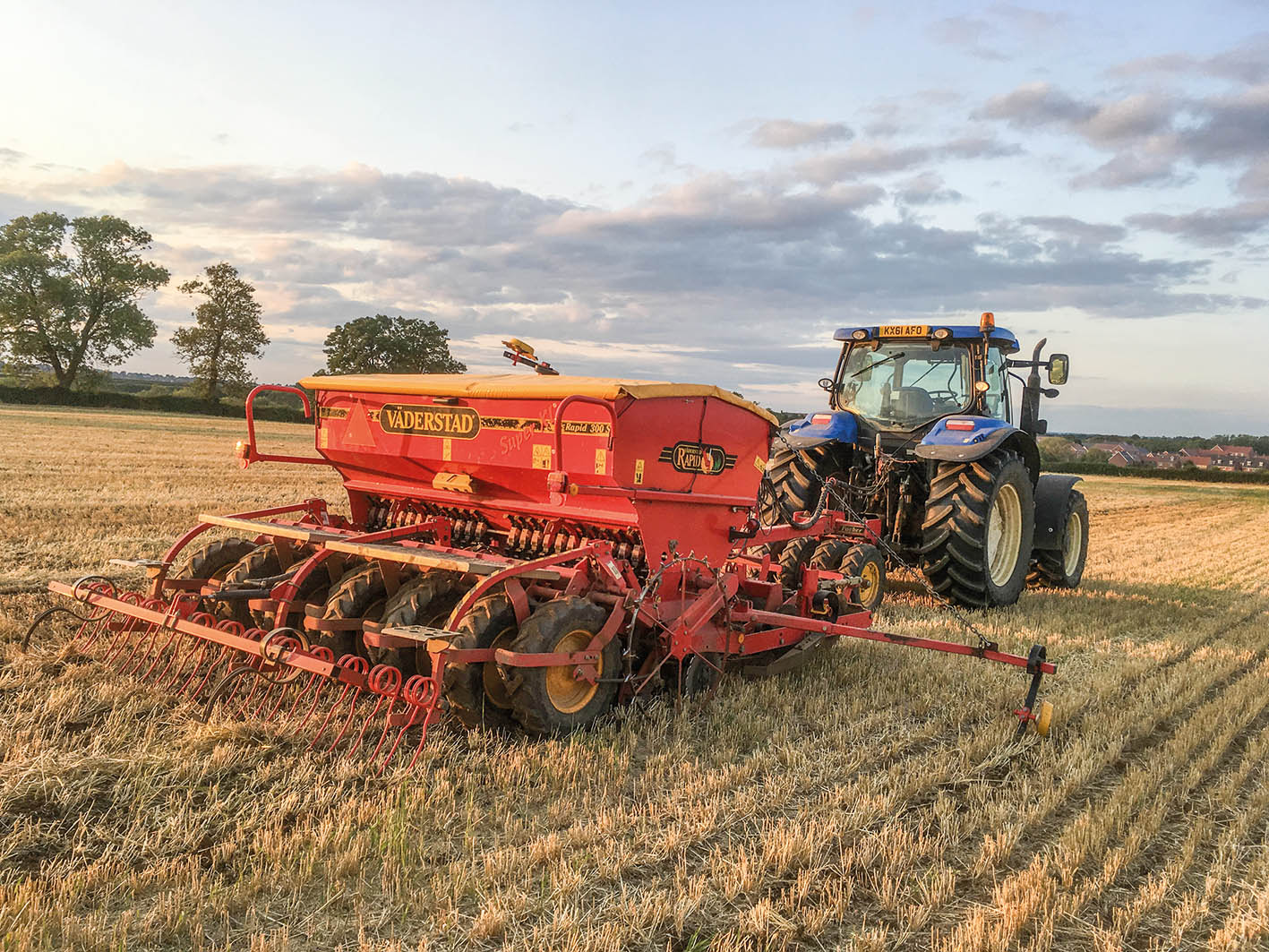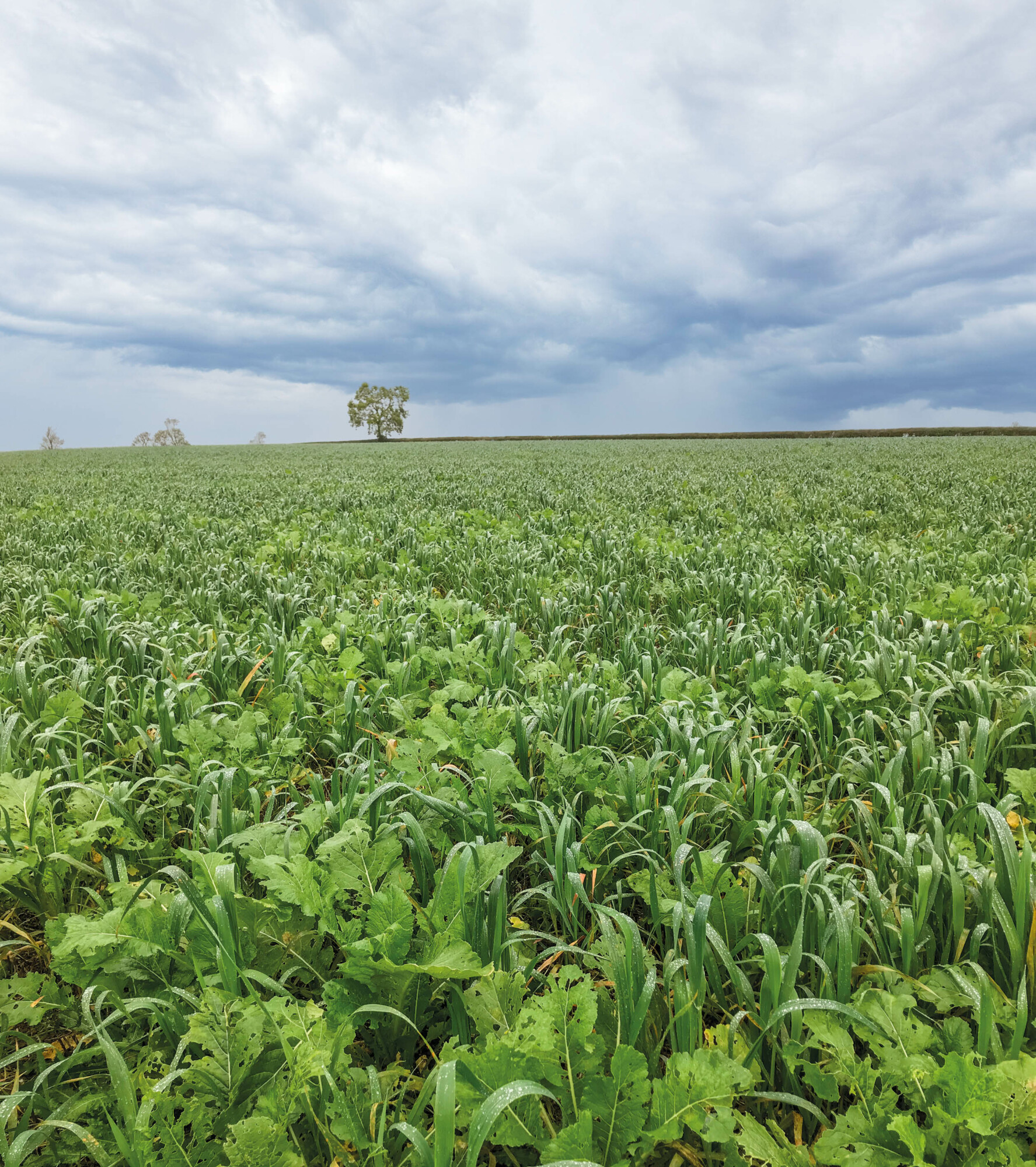Lessons learnt: The path to a regenerative farm
7th March 2022
With the agricultural industry under the spotlight due to the ‘climate crisis’, regenerative farming is a hot topic. However, the ability to be able to change your farming practices comes down to one thing – the bottom line. Rachel Hicks reports.

Richard Heady uses his Vaderstad Rapid ahead of barley drilling.
So how can that balance between revenue and regenerative agriculture be reached? Farmers Guide finds out how two farmers are managing to strike the right balance.
Working with water companies
Speaking at Groundswell last year, John Hawkins (right) of Bagber Farms, Dorset, is an arable tenant farmer who has changed his farming system quite radically in the last few years. These changes have had a positive impact on nitrate leaching in the local bore hole, as well as in Poole harbour. He farms around 280ha on light, sandy soils above chalk.
Mr Hawkins began working with Tim Stephens, catchment advisor for Wessex Water, in 2015 to improve his nitrogen use efficiency and reduce nitrate concentrations.
The whole farm is entered into a Countryside Stewardship Scheme, with half in a legume fallow, and the other half in a spring cropping and cover crop rotation. Reed canary grass was put into place for five years, in place of arable cropping. It provides a useful by-product for his biomass boiler, but the rooting also assists in the reduction of nitrate leaching.
Mr Hawkins’ average rotational leaching across a four-year rotation, according to porous pot data, is down to around 12–15kg N/ha/year leached, compared to where it started in 2015 at around 50kg N/ha/year.
According to Mr Hawkins, it’s tempting to just do the same things that you’ve always done – a set rotation of OSR, followed by winter wheat, followed by two spring barleys, and so on. He reckons that’ll give you just enough profit (if you average your rotation out over 4/5 years) to keep you in business, pay the bills and pay your rent. Except, he says, overheads are going up, while the average commodity price isn’t going up proportionally – and the government are taking subsidies away.
Mr Hawkins commented: “I simply realised that it’s not profitable for me to grow OSR or winter wheat on my light soils. They are high input, high output crops, and if you don’t get it right, you’ll be out-of-pocket. There’s a very fine line between a really profitable harvest with those winter crops, and a loss.
“To get a guaranteed income is nice – if the government is going to offer you money for the mid-tier stewardship options, have a look at what the options are and compare them to what you could earn in the next five-year period by sticking with your same old rotation.”
After using a machinery grant to purchase a SimTech T-Sem direct drill, Mr Hawkins sprays off the fallow, then direct drills it a month later.
He uses farm-saved Propino barley, and also plants wild bird mix in strips between his orchard trees. Mr Hawkins comments: “It’s ironic that you get paid more to feed birds than you do to feed humans at the moment – £639 per ha for wild bird food, which I just punch in and walk away.” Until food prices go up quite a lot more, Mr Hawkins says he won’t regret taking on these CSS options.

Cover crops on Richard Heady’s Buckinghamshire farm.
Spring cropping advantages
Richard Heady (below) farms with his family just outside Milton Keynes, Buckinghamshire. His 438ha farm has a mix of heavy clay and clay loam soils, and he also runs around 200 head of suckler and store cattle, and 70 Texel ewes. Around 100 store lambs from a neighbour graze cover and fodder crops.
Mr Heady’s current rotation is wheat, wheat, barley/oats and beans. But he farms flexibly, and will sometimes add in an extra spring wheat after a cover crop.
He now uses more spring crops, to make use of forage and cover crops, improving soil quality and for black-grass control. The farm has dropped oilseed rape from its rotation due to flea beetle pressure, and to help reduce slug numbers – instead, Mr Heady has brought beans back in to add structure and nutrition to the soil.
He explains: “I was in such a rush to start our zero-till/regenerative agriculture journey that I dived straight into direct drilling. Some fields dealt with this far better than others, depending mainly on soil type, but also the cultivations and care that had come before.
“After two wet autumns and
some very poor crops, I have learnt many lessons, and I am no longer so strict with zero-tillage – but instead treat each field individually. The fields that have transitioned well have remained undisturbed, but this summer we took the opportunity to use a low-disturbance subsoiler to try and correct the damage done by a heavy drill in wet conditions over previous autumns.
“This year we even ploughed a couple of fields that had struggled to produce a decent crop and would have returned a huge weed burden, calling it a reset, before starting from scratch with regen ag principles.
“I use high seed rates, as I would rather spend a few more pounds on seed than on sprays, and a thick, competitive crop is the first line of defence against weeds.
In dry weather, especially in the spring, Mr Heady uses a Weaving GD4001T as a true direct drill with very little disturbance. “We initially used it for everything, but as a 4m drill it is heavy and our clay soils did not appreciate this in damp autumn conditions,” he commented. Last autumn, a lot of crops were drilled with a Kverneland Tsevo, but Mr Heady swapped the standard legs with Weaving sabre tines. “This gives us a direct drilling tine option – it is limited as to its penetration, but performs well in damper conditions (and especially after a subsoiler),” he explained. “We also use an old 3m Vaderstad Rapid, which allows us a light cultivation as an entry to direct drilling, and to give a little tilth to get the barley started. With the aid of a grant, we have recently invested in an Erth Panbuster as a
low-disturbance grassland subsoiler.”
“We try to home-save as much seed as possible, as I do like my higher seed rates – but I am happy to buy in new varieties. I am still trying to find the most cost-effective cover crop mixes, and usually tend to buy in sacks of straight seed (mustard, vetches, turnips etc) to mix with our oats, or beans.”
Around half the farm is in mid-tier stewardship, and Mr Heady reckons that apart from the paperwork, it seems to have been a good way to earn a guaranteed income from the less productive parts of the farm. The rest of the farm has been entered into the Sustainable Farming Incentive Pilot. According to Mr Heady: “The jury is still out on whether this is a good idea; the pros are that every hectare can earn us a return, and some of the standards we are achieving anyway. The negatives are the extra paperwork, more land out of production (5% for the fields in the Arable Land Standard) and that we may have been able to earn more by adding fields into the remaining years of mid-tier. At least being part of the pilot scheme should allow us to have an impact on how the SFI shapes up and I can put any problems or suggestions across.”
With the loss of BPS, and SFI making up only a fraction of this income, Mr Heady thinks it’s important to find other sources of farm income, without removing the focus from actually farming. He is looking into business units to make use of under-utilised farm buildings, but says it’s going to require a change of culture,
as the team have been used to having the farmyard to themselves.
In terms of lessons learnt, Mr Heady said: “The main points I have taken away from my mistakes are:
The weather after direct drilling, on our soils, is just as important as the weather before. Drilling right up to a storm doesn’t allow the soil structure time to settle before getting a soaking, and this can lead to anaerobic soil conditions
Pay closer attention to chopped straw distribution at harvest as this can really affect germination and seed placement when direct drilling
Choose the right point in the rotation to start direct drilling each field – utilising cover crops and spring cropping is a good entry point.”
For more Arable news, visit our website.
